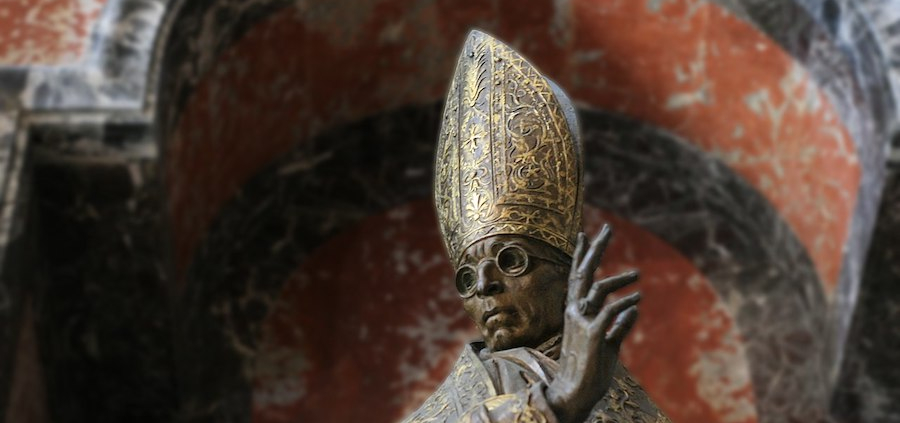Pontifical Politics by Roger Karny
Thank you for printing Tom Bishop’s review of David Kertzer’s book The Pope at War (January, 9, 2023), regarding the dubious actions (or inaction) of Pius XII toward the Jewish population of Europe at the time of World War II.
I would like to first point out, however, to Pius XII’s credit, that it was he who, in his 1950 encyclical Munificentissimus Deus, proclaimed the Dogma of the Assumption, raising the Blessed Virgin Mary to an exalted status in the Catholic Church. This action, according to psychoanalyst Carl Jung, was probably the greatest occurrence in 20th century Catholicism, as it now gave to Christianity the female anima (alongside the male animus) that it had lacked for so long. Jung believed both male and female faith perspectives are needed to mirror the important wholeness of our own souls.
Nonetheless, on a more worldly level, Bishop and Kertzer describe Pius’s reluctance to openly confront Hitler and the Nazis in their attempted liquidation of the Jewish race, as revealed in the recently opened Vatican documents. Both admit the Catholic Church’s disdain toward—and, in fact, outright hostility against—the Jewish people until at least Vatican II, due to the view that the Jewish nation as a whole was responsible for Christ’s death.
An excellent book on this subject, Europe and the Jews, was published in 1950 by a Scottish Catholic layman, Malcolm Hay. Hay accurately points out that while the synoptic gospels place the blame on the Jewish religious leaders, John’s gospel makes no such distinction, seemingly placing Jesus’s death on the Jews as a whole. (See, for example, where John uses the inclusive term “the Jews” in chapter 18, verses 28, 31, 36, and 38; chapter 19, verses 7, 12, 14, 31, and 38; and chapter 20, verse 19 of the crucifixion narrative.) But this, of course, was not John’s real intention. His gospel was merely used afterward to excoriate the Jewish nation throughout the centuries.
Hay shows throughout his detailed historical investigation of 1,900 years of Catholic-Jewish relations that the church believed and acted harshly on this literal reading of John. He cites examples of saints such as John Chrysostom and Bernard of Clairvaux directly naming the Jewish people as Christ-killers in many of their sermons. Their words and those of other clerics were used to promote murderous medieval pogroms against Jewish ghettos, resulting in Jewish land and money falling into the hands of their persecutors. Crusaders even practiced their warrior arts on Jewish citizens of Europe before departing for Jerusalem, according to Hay.
Hay then shows how Hitler and his followers were able to tap into this crude, historical, anti-Jewish sentiment to come up with their “Final Solution” to the Jewish “problem” in Europe: the deadly gas chambers of Nazi concentration camps. Europe was already molded into anti-Semitism long before the 1930s. “It was this spirit of indifference, this cold aloofness of the bystanders, which made it possible for Hitler to turn Europe into a Jewish cemetery,” Hay writes. Pius XII seemed to follow the attitude of the times.
I would like to add some words Albert Camus addressed to the monks of the Dominican Monastery of Latour-Maubourg in 1948 regarding the weak response of Pius XII and the Vatican to Hitler and Mussolini in the 1930s and ’40s:
For a long time during those frightful years I waited for a great voice to speak up in Rome. I, an unbeliever? Precisely. For I knew that the spirit would be lost if it did not utter a cry of condemnation when faced with force. . . .
It has been explained to me since that the condemnation was indeed voiced. But that it was in the style of the encyclicals, which is not at all clear. The condemnation was voiced and it was not understood! . . . What the world expects of Christians is that Christians should speak out, loud and clear, and that they should voice their condemnation in such a way that never a doubt . . . could rise in the heart of the simplest man.
Camus concluded, “But it may be . . . that Christianity will insist on maintaining a compromise or else on giving its condemnations the obscure form of the encyclical. Possibly it will insist on losing once and for all the virtue of revolt and indignation that belonged to it long ago. In that case Christians will live and Christianity will die. In that case the others will in fact pay for the sacrifice.”
Apparently Pius XII preserved the Catholic Church as an institution during a crucial time, believing it could well have been destroyed had Hitler and the Nazis won World War II, as Kertzer points out Pius believed they would. One might say the popes have long been more and better politicians than martyrs and idealists. ♦
Roger Karny is retired and lives near Denver, Colorado. His interests include history and good literature.





Leave a Reply
Want to join the discussion?Feel free to contribute!